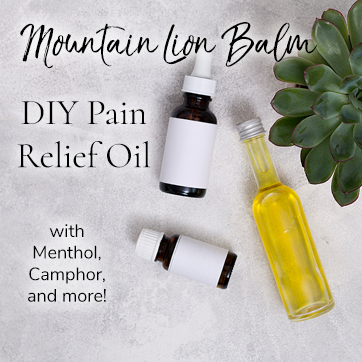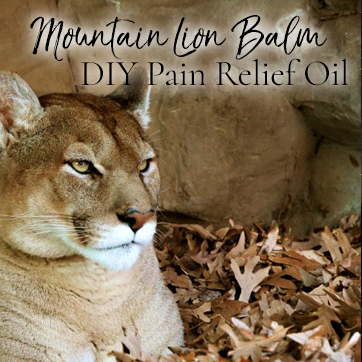
Everyone had aches and pains, whether they struggle with chronic illness or not, and every drug company out there has a goop to fix it. These products work great, inside their narrow scope. The product manufacturers would much rather you spend $5 – $10 or more each time something hurts. Instead, you can create a base pain topical cream, and then customize it to your own needs. This is my base recipe, something I like to call Mountain Lion Balm. It is centered around FDA approved ingredients [1] which are found in most of the over the counter products.
All you need is the ingredients and a container for the final product. A mortar and pestle may make the process easier, but it isn’t necessary. Additionally, you may wish to fill a roller bottle with this, but it is usable without it. I keep mine in a mason jar and refill my roller bottle when it is empty.
Ingredients:
- 1/2 cup grapeseed oil
- 1 tsp menthol crystals
- 15 drops Balsam Fir Needle Essential Oil
- 10 drops Camphor Essential Oil
- 10 drops Wintergreen Essential Oil
Directions:
- Measure the menthol crystals and crush them as much as possible before adding them to the container. They do not need to be completely powdered, but a mortar and pestle helps.
- Add the grapeseed oil to the menthol crystals, and shake or stir to dissolve the crystals as well as possible.
- Add the remaining essential oils and stir to combine.
- Allow the crystals to dissolve for a few hours if they did not mix completely. Otherwise, it is ready to use!
- Mix or shake before use and before filling a secondary container, like a roller bottle.
Always spot check! Even if these products are safe, that doesn’t mean that you won’t be allergic to them.
I prefer to use grapeseed oil for my carrier oil in my thin topical ointments. It rolls out cleanly and absorbs deeply into the skin. Typically the pain I want to address is nerve or arthritis related, and grapeseed oil can deliver the active ingredients where I want them.
Menthol and camphor are all over the pharmacy shelves in different combinations and applications, and at very different price points. Very little of these active ingredients are necessary to be effective, starting at 0.5%! Menthol and camphor together are effective for muscle and joint pain [1]. This formulation has approximately 1.5% active ingredients, which leaves lots of room to personalize it for your own needs.
Wintergreen Oil (or rather, methyl salicylate) is another FDA approved natural compound used to treat muscle pain, osteoarthritis, and rheumatism [7]. It is also available in many over the counter pain preparations, sometimes mixed with Menthol and Camphor. Here is a more detailed article on the benefits and dangers of Wintergreen.
The oil extracted from the bark of the Balsam Fir tree contains many anti-inflammatory components [2] [3]. Native for the northeastern US and southeastern and central Canada, Balsam Fir has been used by the Native Americans/American Indians of the region to treat multiple medical conditions [4]. It has been used by the people on the American continents since, being patented since at least 1869 [5], and current listed in the GRAS list by the FDA [6]. Tested samples of hydrodistilled essential oils show a chemical composition with approximately 26% α-pinene [2]. Alpha pinene is a very potent anti-inflammatory [3], and this targets a prominent source of pain. Balsam Fir oil has many other beneficial compounds, but that will come later in its own post.
Now, the rest is up to you! Make sure to do some research before putting these potent oils in and on your body – and the dose makes the poison!
Do you like WildHemlock.Com?
Support with Paypal!
References:
- Camphor and Menthol Topical, Drugs.com https://www.drugs.com/mtm/camphor-and-menthol-topical.html
- Chemical Composition of the Bark Oil of Balsam Fir Abies balsamea (L.) Mill. https://www.tandfonline.com/doi/abs/10.1080/10412905.1996.9700636
- Anti-inflammatory and chondroprotective activity of (+)-α-pinene: structural and enantiomeric selectivity. https://www.ncbi.nlm.nih.gov/pubmed/24455984
- “Balsam Fir.” A Handbook of Native American Herbs, by Alma R. Hutchens, Shambhala Publications, 1992, pp. 11–13. https://books.google.com/books?id=V2RSR0O2OK0C
- Oglesbey, William. Improved Salve. US 98400A. US Patent and Trademark Office, 28 December 1869. https://patents.google.com/patent/US98400
- FDA CFR Title 21, Chapter 1, Subchapter B, Section F https://www.accessdata.fda.gov/scripts/cdrh/cfdocs/cfcfr/CFRSearch.cfm?fr=172.510
- Methyl Salicylate, Drugs.com https://www.drugs.com/ingredient/methyl-salicylate.html

